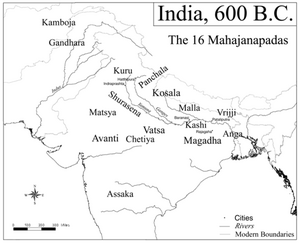Ashmaka

Ashmaka (अश्मक) was a region of ancient India (700–300 BCE) mentioned in Ashtadhyayi of Panini as janapada Aśhmaka (अश्मक) (IV.1.173).[1] It was one of the sixteen mahajanapadas in the 6th century BCE, mentioned in the Buddhist text Anguttara Nikaya. They fought Mahabharata War in Pandava's side.
Origin of name
Ashmaka is derived from Sanskrit word "Ashma" which means Stone or Gem: In fact one finds thousands of hillocks and stones in this region and thus aptly called Ashmaka.
Variants of name
Location
The region was located on the banks of the Godavari river, between the rivers Godavari and Manjira. It was the only Mahajanapada situated to the south of the Vindhya Range, and was in Dakshinapatha. It corresponds to districts Nizamabad and parts of Adilabad in Telangana and Nanded, Yavatmal in Maharashtra states in current-day India.
Jat clans
Mention by Panini
Ashmaka (अश्मक) is a term mentioned by Panini in Ashtadhyayi. [2]
Asika (आसिक), swordsman, is mentioned by Panini in Ashtadhyayi. [3]
History
V. S. Agrawala[4] writes that Ashtadhyayi of Panini mentions janapada Aśhmaka (अश्मक) (IV.1.173) - Panini refers Avantyaśmakaḥ (Avanti+Ashmaka), showing their geographical proximity. Aśhmaka is named Assaka in Pali texts with its capital at Paithan Pratishthana on Godawari River.
The Buddhist text Mahagovinda Suttanta mentions about a ruler of Assaka, Brahmadatta who ruled from Potali or Podana, which now lies in the Nandura Tehsil of Buldhana district in Maharashtra.[5]
The Matsya Purana (ch.272) lists twenty-five rulers of Aśmaka, contemporary to the Shishunaga rulers of Magadha.
Later, the people spread southward to the territory of the Rashtrakuta empire, which is now in modern Maharashtra.
Ashmaka is also identified as Assaka and Aśvakas in Buddhist literature and Gatha Saptashati of king Hāla.
The Mahabharata Tribe - Asmaka (अश्मक) - The Puranas associate them with the Iksvaku line of Kshatriyas and Buddha scriptures refer to their land as a Mahajanapada. Identified with Paithan in Aurangabad district, this janapada may have comprised modern Nasik and Aurangabad Maharashtra. They fought with the Pandavas (VII. 61.39). [6]
अश्मक - अस्सक - अश्मत
विजयेन्द्र कुमार माथुर[7] ने लेख किया है ...अश्मक, अस्सक, अश्मत (AS, p.49): अश्मक अथवा अस्सक महाजनपद पौराणिक 16 महाजनपदों में से एक था। नर्मदा और गोदावरी नदियों के बीच अवस्थित इस प्रदेश की राजधानी 'पाटन' थी। आधुनिक काल में इस प्रदेश को महाराष्ट्र कहते हैं।
बौद्ध साहित्य में इस प्रदेश का उल्लेख मिलता है, जो गोदावरी के तट पर स्थित था। 'महागोविन्दसूत्तन्त' के अनुसार यह प्रदेश रेणु और धृतराष्ट्र के समय में विद्यमान था। इस ग्रन्थ में अस्सक के राजा ब्रह्मदत्त का उल्लेख है। सुत्तनिपात (997) में अस्सक को गोदावरी तट पर स्थित बताया गया है। इसकी राजधानी पोतन, पौदन्य या पैठान (प्रतिष्ठान) में थी। पाणिनि ने अष्टाध्यायी (4,1,173) में भी अश्मकों का उल्लेख किया है। सोननंदजातक में अस्सक को अवंती से सम्बंधित कहा गया है। अश्मक नामक राजा का उल्लेख वायु पुराण (88, 177-178) और महाभारत में है--'अश्मकों नाम राजर्षि: पौदन्यं योन्यवेशयत्'। सम्भवत: इसी राजा के नाम से यह जनपद अश्मक कहलाया। ग्रीक लेखकों ने अस्सकेनोई (Assakenoi) लोगों का उत्तर-पश्चिमी भारत में उल्लेख किया है। इनका दक्षिणी अश्वकों से ऐतिहासिक सम्बन्ध रहा होगा या यह अश्वकों का रूपान्तर हो सकता है। (दे. अश्वक)
Jat History
Hukum Singh Panwar (Pauria) [8] writes that The Auchatai of Herodotus were Osseti or Allan known to the Russian writers as As[9] who seem to be none else than Asii[10] of the later Greek scholars and the Asikas or Assakas or Asmakas of the Asikas or Assakas or Asmakas or the ancient Indian sources[11].
Mahabharata
They were known as Asika/Asmaka/Assaka/Ashmaka in Mahabharata.
The Mahabharata Tribe - Asmaka (अश्मक) is associate with the Iksvaku line of Kshatriyas in Puranas and Buddhist scriptures refer to their land as a Mahajanapada. Identified with Paithan in Aurangabad district, this janapada may have comprised modern Nasik and Aurangabad. Fought with the Pandavas.[12]
Bhisma Parva, Mahabharata/Book VI Chapter 10 mentions about province of Asmaka along with Munda, Sunda, Vidarbha, Asika, Pansurashtra and Goparashtra in verse Mahabharata(VI.10.42). [13]
Drona Parva Mahabharata mentions Asmakas with Kekayas in verse Mahabharata (VII. 61.39). [14]
External links
References
- ↑ V. S. Agrawala: India as Known to Panini, 1953, p.61
- ↑ V. S. Agrawala: India as Known to Panini, 1953, p.38, 61, 425
- ↑ V. S. Agrawala: India as Known to Panini, 1953, p.420
- ↑ V. S. Agrawala: India as Known to Panini, 1953, p.61
- ↑ Raychaudhuri, Hemchandra (1972) Political History of Ancient India, University of Calcutta, Mumbai, p.80
- ↑ धृष्टथ्युम्नश च थुर्धर्षः शिखण्डी चापराजितः, अश्मकाः केकयाश चैव कषत्रधर्मा च सौमकिः (VII. 61.39)
- ↑ Aitihasik Sthanavali by Vijayendra Kumar Mathur, p.49
- ↑ The Jats:Their Origin, Antiquity and Migrations/The identification of the Jats,p.312
- ↑ Bongard-Levin, op.cit., p.23; Budha Prakash, op.cit., P.97
- ↑ The original name of Hansi (Haryana) town in the heart of Jats is Asi or Asika (Imp. Gaz. of Ind., Vol. XIII, p.25).
- ↑ Chaudhuri, S.B., op.cit., pp.49-52 70f, Budha Prakash, op.cit., p.97.
- ↑ Mahabharata (VII. 61.39)
- ↑ गॊविन्दा मन्दकाः षण्डा विदर्भानूपवासिकाः, अश्मकाः पांसुराष्ट्राश च गॊप राष्ट्राः पनीतकाः Mahabharata(VI.10.42)
- ↑ धृष्टथ्युम्नश च थुर्धर्षः शिखण्डी चापराजितः, अश्मकाः केकयाश चैव कषत्रधर्मा च सौमकिः Mahabharata (VII. 61.39)

